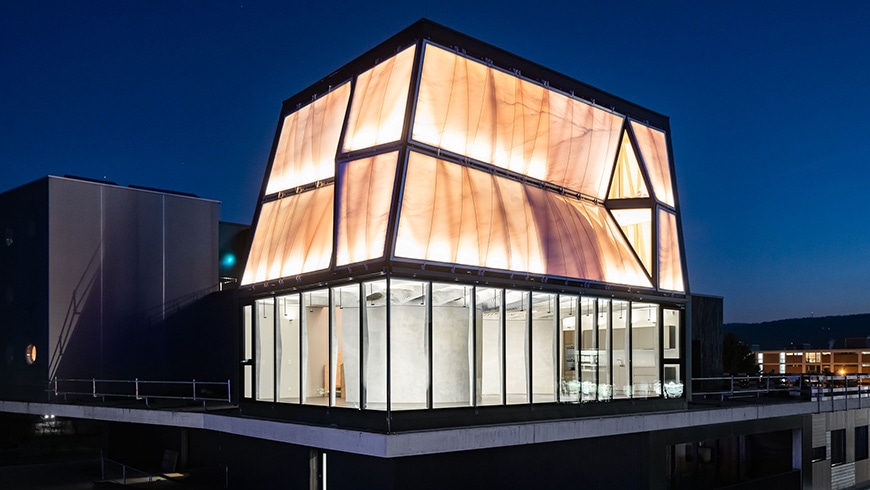Feb 28 2019
On February 27th, 2019, DFAB HOUSE was officially opened on the NEST building of Empa and Eawag in Dübendorf.
 A delicate concrete ceiling—cast in 3D-printed formwork—and a curved concrete wall created by a construction robot characterize the architecture of the living room, whose aesthetics are remotely reminiscent of the film sets of the Swiss artist HR Giger (the creator of “Alien”). Upon saying a specific command, the blinds open as if by magic and the kettle prepares water for tea. What sounds like a science fiction film is reality in Dübendorf: today, the smart and largely digitally planned and built DFAB HOUSE opens its doors. (Image credit: Roman Keller)
A delicate concrete ceiling—cast in 3D-printed formwork—and a curved concrete wall created by a construction robot characterize the architecture of the living room, whose aesthetics are remotely reminiscent of the film sets of the Swiss artist HR Giger (the creator of “Alien”). Upon saying a specific command, the blinds open as if by magic and the kettle prepares water for tea. What sounds like a science fiction film is reality in Dübendorf: today, the smart and largely digitally planned and built DFAB HOUSE opens its doors. (Image credit: Roman Keller)
DFAB HOUSE is considered to be the very first inhabited “house” that was digitally planned and also built digitally to a great extent by using 3D printers and robots. ETH Zurich researchers developed the construction technologies by teaming with industrial partners.
From Laboratory to Architectural Application
DFAB HOUSE is a three-story “house” set on the topmost of three platforms at NEST. Researchers, by collaborating with industrial partners, can use this modular research and innovation building of Empa and Eawag to test new construction and energy technologies under real-life surroundings. NEST has a central building core to which units (different building units) can dock. For constructing this house, researchers teamed with industrial partners and for the very first time transferred a number of innovative digital construction technologies from the laboratory into real-world applications. These researchers were from eight professorships at ETH Zurich, within the framework of the National Center of Competence in Research (NCCR) “Digital Fabrication.”
Digital technologies aim to make planning and construction more efficient, as well as greatly sustainable. For instance, the digitally planned floor slab of DFAB HOUSE has been structurally and statically optimized in such a manner that it is possible to save substantial amounts of material when compared to a standard concrete slab. The technologies also make room for new design possibilities. For example, wooden frames have been used for characterizing the two upper residential floors, and these frames were fabricated by using two construction robots and arranged in intricate geometries.
The architectural potential of digital fabrication technologies is immense. Unfortunately, these technologies are still scarcely used on construction sites. With the DFAB HOUSE, we are able to test new technologies hand in hand with industry and thus accelerate the transfer from research to practice.
Matthias Kohler, Professor of Architecture and Digital Fabrication, ETH Zurich
An Intelligent Home
Academic guests from Empa and Eawag will be the first residents to move into this house within the next two months. At DFAB HOUSE, they will indeed stay in an intelligent home. The first smart home solutions in DFAB HOUSE were installed by a group of companies headed by digitalSTROM, and these solutions have been based on the manufacturer-independent digitalSTROM platform. These comprise of smart, multi-stage burglar protection, automated glare and shading options, including the modern generation of networked, intelligent household appliances.
However, DFAB HOUSE is considered to be smart in terms of home electronics and also with regards to energy management: On average, photovoltaic modules on the roof supply one and a half times the amount of electricity that the unit itself will consume, whereas an intelligent control system is capable of coordinating all consumption, thus guaranteeing that no load peaks happen. Two start-up ideas, assisted by researchers from Empa and Eawag, are making efforts to save extra energy: Based on the first idea, heat generated from wastewater, which would generally be lost, is directly recovered in the shower trays through heat exchangers, and the other idea explains how hot water (when not used) flows from the pipes back into the boiler instead of just cooling in the water pipes. Besides saving energy and water, this method also decreases the threat of bacteria growing in the pipes.
Research and Industry Learn from Each Other
The sixth unit in the NEST research and innovation building is the best example of how collaboration between researchers and industry can yield progressive solutions.
In implementing a construction project like DFAB HOUSE, traditional construction methods meet new concepts of the digital world. The path from the digital drawing board to an actual building has challenged both scientists and experts from industry. Through a constructive dialog, something truly visionary can now be put into practice; hopefully it will soon be used broadly in the construction industry.
Gian-Luca Bona, CEO, Empa
DFAB HOUSE
Video credit: Empa